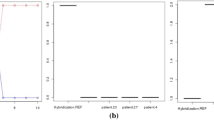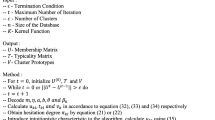Abstract
Using clustering analysis for identifying cancer types in high-dimensional microarray gene expression cancer database is extremely difficult task because of high-dimensionality gene with noise. Most of the existing clustering methods for microarray gene expression cancer database to achieve types of cancers often hamper the interpretability of the structure. Hence, this paper presents effective fuzzy c-means by incorporating the membership function of fuzzy c-means, the typicality of possibilistic c-means approaches, normed kernel-induced distance, to find cancer subtypes in the microarray gene expression cancer database. This paper successfully finds the subtypes of cancers in microarray gene expression cancer database using the proposed method. The superiority of the proposed method has been proved through clustering accuracy.










Similar content being viewed by others
References
Alon U (1999) Broad patterns of gene expression revealed by clustering analysis of tumor and normal colon tissues probed by oligonucleotide arrays. Proc Natl Acad Sci USA 96(12):6745–6750
Bezdek JC (1981) Pattern recognition with Fuzzy objective function algorithms. Plenum Press, New York
Chen H-L, Yang B, Liu J, Liu D-Y (2011) A support vector machine classifier with rough set-based feature selection for breast cancer diagnosis. Expert Syst Appl 38:9014–9022
Coppi R et al (2012) Fuzzy and possibilistic clustering for fuzzy data. Comput Stat Data Anal 56(4):915–927
De Bin R et al (2011) A novel approach to the clustering of microarray data via nonparametric density estimation. BMC Bioinform 12(1):49–56
Hartigan JA (1975) Clustering algorithms. Wiley, New York
Hawes SE et al (2010) DNA hypermethylation of tumors from non-small cell lung cancer (NSCLC) patients is associated with gender and histologic type. Lung Cancer 69:172–179
He Z, Xu X, Deng S (2005) A cluster ensemble method for clustering categorical data. Inf Fusion 6(2):143–151
Kanzawa Y, Endo Y, Miyamoto S (2008) Fuzzy classification function of entropy regularized fuzzy c-means algorithm for data with tolerance using kernel function. In: The 2008 IEEE International Conference on Granular Computing, pp 350–355
Kashef R et al (2010) Cooperative clustering. Pattern Recognit 43:2315–2329
Kumar S et al (2012) Development of an efficient clustering technique for colon dataset. Int J Eng Innov Technol 1(5):83–86
Mclachlan GJ et al (2002) A mixture model based approach to the clustering of micro-array expression data. Bio Inform 18(3):413–422
Parkin DM, Bray F, Ferlay J, Pisani P (2005) Global cancer statistics. CA Cancer J Clin 55(2):74–108
Rousseeuw PJ (1987) Silhouettes: a graphical aid to the interpretation and validation of cluster analysis. J Comput Appl Math 20:53–65
Thomas R, Thieffry D, Kaufman M (1995) Dynamical behaviour of biological regulatory networks—I. Bull Math Biol 57:247–276 17
Tjhi W-C, Chen L (2007) Possibilistic fuzzy co-clustering of large document collections. Pattern Recognit 40(12):3452–3466
Turm H et al (2014) Comprehensive analysis of transcription dynamics from brain samples following behavioral experience. J Vis Exp 90:e51642–e51642. doi:10.3791/51642
Vanisri D et al (2011) An efficient fuzzy possibilistic C-means with penalized and compensated constraints. Global J Comput Sci Technol 11(3):15–21
Yu Z, Wong HS, Wang H (2007) Graph based consensus clustering for class discovery from gene expression data. Bioinformatics 23(21):2888–2896
Acknowledgments
This work was supported by Indo Taiwan Joint Research Project, DST India & NSC Taiwan.
Author information
Authors and Affiliations
Corresponding author
Ethics declarations
Conflict of interest
None.
Human and animal rights
This article does not contain any studies with human participants or animals performed by any of the authors.
Additional information
Communicated by C.-H. Chen.
Rights and permissions
About this article
Cite this article
Kannan, S.R., Devi, R., Ramathilagam, S. et al. Effective fuzzy possibilistic c-means: an analyzing cancer medical database. Soft Comput 21, 2835–2845 (2017). https://doi.org/10.1007/s00500-016-2198-7
Published:
Issue Date:
DOI: https://doi.org/10.1007/s00500-016-2198-7




